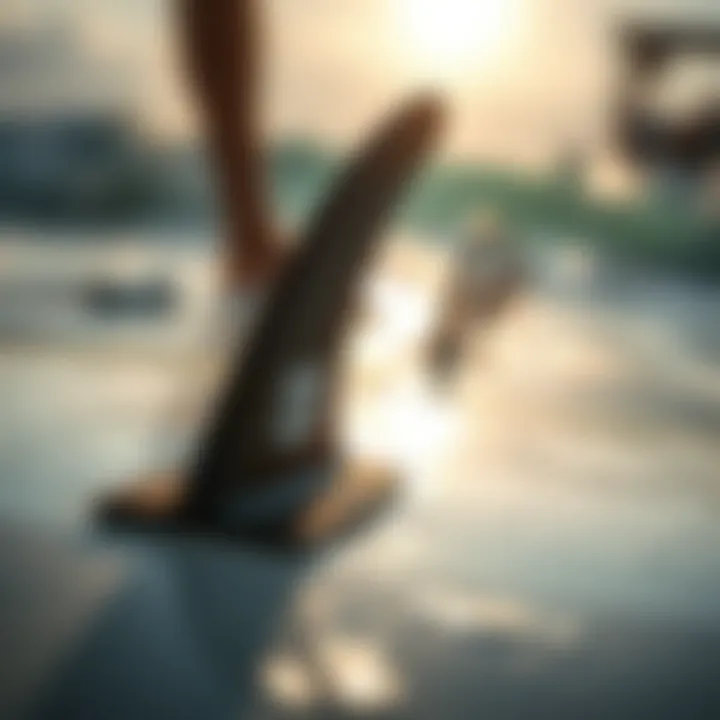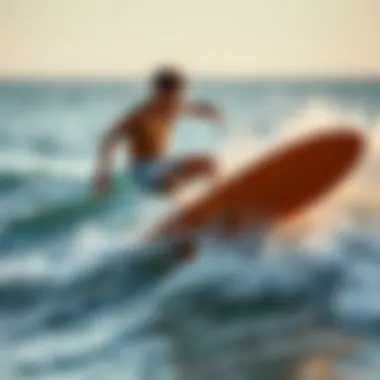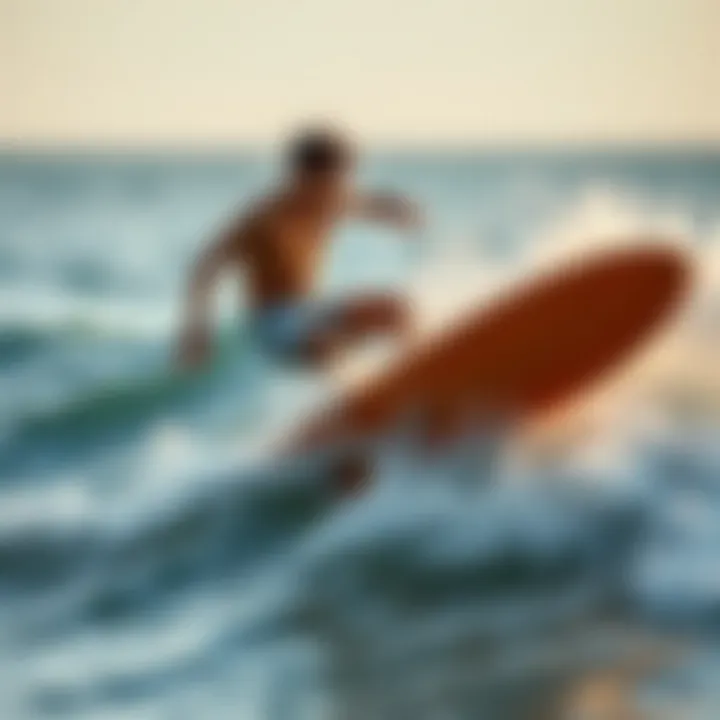Discovering the Best Body Boards for Every Surfer


Extreme Sport Overview
Bodyboarding, a thrilling offshoot of surfing, has grown in popularity over the years and is often seen as a more accessible alternative for water sports enthusiasts. This unique sport involves riding ocean waves while lying belly-down on a buoyant board, maneuvering through swells with speed and agility. Let's take a dive into its history, requirements, and safety considerations.
Brief History of Bodyboarding
The roots of bodyboarding can be traced back to ancient Polynesian cultures, where it was common to ride waves on hand-crafted boards, often made from materials like wood or palm fronds. The contemporary version of bodyboarding emerged in the 1970s, revolutionized by the likes of Tom Morey, who invented the iconic boogie board, paving the way for a new wave of extreme athletes. The 1980s and 90s saw the sport soar in popularity, leading to competitions and professional athletes coming to the forefront.
Equipment Required
Engaging in bodyboarding requires a few essential pieces of equipment for both safety and performance:
- Bodyboard: Available in various sizes and materials, tailored for different skill levels and wave conditions.
- Fins: Essential for propulsion and maneuverability in the water.
- Leash: A safety feature that keeps the board attached to the rider, preventing it from drifting away.
- Wetsuit: Provides warmth and protection against scrapes from the ocean floor or surfboard collisions.
Safety Tips and Guidelines
Before hitting the waves, it’s crucial to adhere to some safety practices. Here are a few tips to enhance safety:
- Know the area: Familiarize yourself with the beach and its specific conditions, such as currents and local wildlife.
- Surf with a buddy: Having someone next to you ensures help is at hand in case of trouble.
- Respect the surf: Be aware of other surfers and bodyboarders in the area, maintaining a safe distance and not dropping in on someone else's wave.
"Bodyboarding is not just about riding waves; it's about respecting the ocean and understanding your limits."
Relevant Statistics and Facts
- According to the World Surf League, the number of bodyboarders worldwide has seen an increase of more than 15% over the last decade.
- A report from the Australian Sports Commission cites that bodyboarding is particularly popular among youth, with nearly 40% of participants aged between 15 and 24 years.
In summary, bodyboarding is not only a sport but a lifestyle embraced by many. It offers a mix of adrenaline and connection with the ocean, providing an exhilarating experience for those brave enough to ride its waves.
Prelims to Bodyboarding
Bodyboarding is more than just a sport; it's a lifestyle that resonates deeply with those who find solace in the surf and thrill in the waves. For both the novice sliding atop foamy curls and the seasoned riders conquering gnarled swells, understanding bodyboarding's nuances is crucial. This part of the guide serves as a launchpad into the fascinating world of bodyboarding, highlighting its significance and the myriad factors that contribute to its appeal.
In this section, we’ll explore the origins of bodyboarding to give readers a sense of its rich history. How did this art form evolve from simple board riding into the vibrant culture we see today? Then, we'll delve into bodyboarding versus surfing, illustrating the key differences and how they cater to varied preferences and skill levels. These insights help demystify the fundamentals not just for beginners but also for enthusiasts looking to dive deeper into the discipline.
The Origins of Bodyboarding
Bodyboarding has its roots steeped in a mix of old traditions and modern innovation. Originating from the ancient Polynesians, who would ride on wooden boards in the warm waters of the Pacific, the sport began to take shape as we know it in the mid-20th century. A pivotal moment came in the 1970s, when Tom Morey introduced the first modern bodyboard made of foam, transforming the way enthusiasts could experience the ocean.
From its humble beginnings, the sport gained traction. The Morey Boogie Board, as it was initially called, set off a wave of interest, leading to competitions and a burgeoning community. Enthusiasts quickly adopted a spirit of camaraderie, fostering a culture where sharing tips and techniques became the norm, creating a tight-knit family around the ride.
"Bodyboarding captures the essence of ocean adventure; it’s accessible, thrilling, and sustainable" - an adage that resonates within the community.
Bodyboarding vs. Surfing
While both bodyboarding and surfing involve riding waves, they differ in significant ways that cater to various levels of experience and preferences. Here are key distinguishing factors:
- Equipment: Bodyboarders use shorter boards typically made from flexible materials, allowing for more mobility. Surfers, in contrast, wield longer, stiffer boards that require different techniques.
- Riding Technique: Bodyboarding allows for both prone and drop-knee positions, which provides versatility for riders. Surfing is generally performed standing up, demanding more balance and skill.
- Skill Development: Bodyboarding tends to be more accessible for beginners, making it easier to learn the basic skills without the steep learning curve associated with surfing.
- Wave Types: Each discipline has preferences when it comes to wave conditions. Bodyboarders often thrive in weaker, smaller waves, while surfers typically seek out larger, steeper waves.
Key Characteristics of Quality Body Boards
When it comes to bodyboarding, having the right gear is essential. Quality body boards can make the difference between an exhilarating ride and a disappointing session. Understanding the characteristics that define a top-notch body board is crucial for both beginners and experienced riders alike. It helps in making informed decisions, ensuring that you get a board that suits your skill level and style. Let's dive into the specifics and examine the primary features that contribute to a high-quality body board.
Construction Materials
The construction of a body board is most critical in determining its performance and durability. Different materials offer unique advantages and disadvantages, impacting how the board performs in various surf conditions.
Polystyrene
Polystyrene is a lightweight option that’s commonly used in body board construction. Its main strength lies in its buoyancy, which provides excellent floatation on water. What’s more, this material tends to be more affordable. For those just starting out, this can be an attractive factor. However, it’s worth noting that polystyrene may not hold up as well under intense use, especially in rough waters.
Polyethylene
Polyethylene bodies are known for their sturdiness. This material offers a higher density, which means it can handle the wear and tear better than polystyrene. The significant advantage here is durability; it’s designed to withstand harsher conditions, making it favorable for more aggressive riders. However, it can give a heavier feel — something to consider if you’re looking for speed.


EVA Foam
EVA foam is often used for the board's surface due to its shock-absorbent properties. This adds a layer of comfort, especially after a wipeout. The soft surface can prevent injuries during falls, making it a popular choice among enthusiasts. However, while EVA foam offers excellent grip, it may not be as durable as other materials, especially in high-usage situations.
Dimensions and Shape
The dimensions and shape of a body board are vital, as they affect speed, maneuverability, and stability. Understanding how these factors come into play can drastically change your riding experience.
Length
The length of a body board can determine how well it cuts through waves. Longer boards tend to be more stable and are better suited for larger waves. If speed is your game, going shorter might be the way to go, as shorter boards allow for sharper turns and rapid maneuvers in smaller surf. So, it’s essential to choose a length that fits both your size and the conditions you expect to ride.
Width
Width plays a role in the board’s buoyancy and control. A wider board can provide more surface area for stability, which is fantastic for beginners who might struggle with balance. On the flip side, narrower boards facilitate better maneuverability, making them suitable for advanced riders looking to perform tricks. Thus, it’s a balancing act based on your skill level and preferred riding style.
Thickness
While it might seem like an afterthought, thickness influences floatation and wave response. Thicker boards usually offer more buoyancy, which can be exceptionally helpful in challenging surf. However, thicker boards may be harder to maneuver. If you prefer a more responsive feel on the waves, thinner boards may be your ticket.
Tail Design
The tail design of a body board has a significant impact on how it reacts in water. Each tail shape serves a purpose, catering to different riding styles and conditions.
Square Tail
A square tail is often preferred for its stability and ease of control in small to medium waves. The corners provide a stronger grip on the water, making it suitable for more casual riding. However, it may lack some responsiveness needed for aggressive maneuvers.
Round Tail
Round tails offer greater maneuverability, which is ideal for doing tricks and riding larger waves. The rounded edges help with smooth transitions and arcs in the water. If you’re looking for an agile board, a round tail might be the best choice.
Bat Tail
The bat tail combines characteristics from both square and round tails, providing a unique balance of stability and maneuverability. It allows for quick turns while delivering solid grip. This can be a versatile option for bodyboarders who enjoy a mix of casual rides and aggressive maneuvers.
Understanding these key characteristics can significantly enhance your bodyboarding experience. By assessing materials, dimensions, and tail designs, you're more equipped to select the perfect board that complements your riding style and conditions.
Top Body Boards on the Market
When it comes to bodyboarding, selecting the right board can significantly enhance not just your performance, but also your enjoyment. The top body boards available on the market cater to a variety of styles, skill levels, and personal preferences, making it crucial to understand what sets each brand apart. By assessing not only the specifications but also how these boards perform under real-world conditions, you can make an informed decision that better fits your individual needs.
Understanding the features and nuances of these boards aids in identifying which one may give you the edge in the surf. Whether you’re a seasoned player looking to refine your skills or a newcomer eager to ride those killer waves, knowing the right boards will steer you in the right direction. The importance lies in recognizing that each facet—from material composition to design elements—plays a notable role in your bodyboarding experience.
Brand A: Specifications and Features
Brand A is a standout name in the bodyboarding industry, consistently turning heads with its innovative designs and robust performance metrics. This brand focuses on the key areas that define a quality body board.
- Material: Many of their boards are fashioned from high-end materials like polystyrene, ensuring they are not only lightweight but also highly buoyant.
- Dimensions: With options spanning various lengths and widths, Brand A accommodates a multitude of rider sizes and skill levels. Standard widths give good stability in different surf conditions.
- Tail Design: Brand A often employs a square tail design that enhances maneuverability, making sharp turns easier while still maintaining speed.
These features collectively underscore Brand A’s reputation for delivering durable and high-performing boards that appeal to different segments of bodyboard enthusiasts.
Brand B: Unique Selling Points
What makes Brand B unique in the crowded bodyboarding market? It's all about their standout attributes that set them apart from competitors.
- Innovative Technology: They harness cutting-edge technology in their board construction, which includes tailored flex characteristics designed to suit specific wave conditions.
- Customizability: An appealing aspect is their variety of customizable designs, allowing users to choose colors and graphics that express their personal style.
- Expert Endorsements: Many professional bodyboarders endorse Brand B, adding credibility to the quality and performance of their products. Their boards have been tested in various venues around the globe, from Hawaii to the shores of Australia.
Brand B effectively combines performance enhancement with personalization, making their boards a popular choice for many riders.
Brand C: User Reviews and Reputation
Brand C has cultivated a robust reputation in the bodyboarding community. Analyzing user reviews reveals much about their boards’ performance and overall quality.
- Customer Feedback: Many reviews highlight the sturdiness of Brand C boards, emphasizing durability against everyday wear and tear, particularly in rocky shorelines.
- Overall Satisfaction: The consensus among users is that these boards offer great value for money, even for those new to bodyboarding. Riders appreciate the balance achieved between performance and cost.
- Community Trust: Brand C has built a solid community of followers who actively share their stories and feedback on forums like Reddit. This open communication fosters a sense of trust and reliability.


With a focus on user experience and satisfaction, Brand C stands out not just for its products, but for how it engages with its customer base, ultimately strengthening its place in the market.
"Choosing the right body board can enhance your confidence and skills in the water immensely." - Bodyboarding Enthusiast
Whether you're ready to hit the waves on a steady Brand C board, aim for the innovations of Brand B, or explore the vessel-like offerings of Brand A, remember that understanding what each has to offer will lead to a better ride.
For more insights and user discussions, check out platforms like Wikipedia, Reddit, and Britannica.
By weighing these options carefully, you can ensure that your time spent in the water is nothing short of extraordinary.
Performance Metrics in Bodyboarding
Bodyboarding is not just about riding the waves; it's an art that demands a deep understanding of various performance metrics. These metrics are crucial in determining how effectively and enjoyably a bodyboard can be used in the surf. Knowledge of speed, maneuverability, stability, and durability sets a solid foundation for any athlete looking to enhance their bodyboarding experience. Choosing the right body board based on these metrics contributes immensely to performance, allowing surfers to make informed decisions tailored to their skill level and surfing style.
Speed and Maneuverability
Lighting up the water with swift moves is something every bodyboarder aspires to achieve. Speed in bodyboarding is often a tug-of-war between design and the rider’s input. A board's shape and construction materials weigh heavily on how fast it can glide across the water. For instance, boards made from lightweight polystyrene typically excel in speed, allowing the rider to pick up momentum quickly, particularly in smaller waves.
Maneuverability, on the other hand, relates to how easily a bodyboard can be turned or adjusted during a ride. This agility is vital for performing tricks or riding larger waves where quick changes in direction can mean the difference between a thrilling ride and a nasty wipeout. A board with a rounded tail tends to offer better maneuverability compared to a square tail, giving the rider more control during those twisty turns. This ability to shift direction swiftly not only enhances the ride but also showcases the rider’s skill, hinting at a more seasoned performance.
Stability in Various Conditions
Stability can be the unsung hero of a good ride; it provides a sense of security, particularly in challenging surf conditions. A stable board keeps the rider balanced, minimizing the chance of being tossed around by sudden wave surges. Bodyboards with a wider base often exhibit better stability, absorbing the shocks from rough waters.
Consider the impact of changing conditions. Warm, sunny days may lead to mellow surf, while windy, choppy weather calls for a bodyboard that can hold its ground. For instance, if you're looking to tackle a heavy shore break, opting for a thicker, heavier board can lend additional stability to withstand the surf's relentless assault. Knowing your local water conditions helps in choosing a board that will not just float but will also surf effectively, enhancing overall performance.
Durability and Longevity
In the realm of extreme sports, the longevity of equipment can make or break a bodyboarder’s adventure. A durable body board withstands the test of time, allowing scenes of exhilarating rides without the constant worry of wear and tear. Materials play a significant role here; boards crafted from high-density polyethylene tend to hold up well over time, resisting dings and scrapes.
Moreover, the construction process, along with proper care, ensures that a board lasts longer. Keeping an eye on common issues like surface cracks or delamination can save you from early replacements. Regular maintenance, such as rinsing off salt after each session and using appropriate storage solutions, can drastically increase a board's lifespan. Knowing how to care for a board can mean the difference between a season of great rides or an early season ending due to damage.
"Performance is a blend of science and passion, making it essential to understand the metrics that contribute to an exceptional bodyboarding experience."
In summary, honing in on these performance metrics arms bodyboarders with the knowledge needed to become formidable athletes, taking their skills from the beach to the big waves with confidence.
Choosing the Right Body Board
Selecting the proper body board can be the difference between carving magnificent waves with dexterity and feeling like you’re wrestling an elephant in the water. Each rider brings a unique set of skills and preferences to the quiver, underscoring the importance of careful consideration in choosing a body board. Factors such as skill level, personal style, and even the type of waves you plan to ride can greatly influence your decision. A mismatch can lead to frustration rather than the thrill that bodyboarding should deliver. Thus, understanding the characteristics and requirements for different skill levels becomes pivotal for both newcomers and seasoned riders alike.
Skill Level Considerations
Beginner
For those just stepping into the thrilling world of bodyboarding, opting for the right board is essential for fostering a positive introduction to the sport. Beginner boards are often characterized by a wider surface area, contributing to better stability and ease of use. These boards are a popular choice for novices because they help to build confidence in the water.
A notable feature of beginner body boards is their buoyancy, which provides extra support to new riders. However, they can sometimes lack the responsiveness that more experienced riders may seek. A drawback might be that as the beginner advances, they may outgrow the characteristics of these boards faster than anticipated.
Intermediate
As riders progress in skill, the focus often shifts towards performance and versatility. Intermediate boards strike a balance between stability and responsiveness. They typically have a slightly narrower design, allowing for enhanced maneuverability in moderate to challenging wave conditions.
A key characteristic here is the construction material, often featuring more durable substances compared to beginner boards. This resilience means that intermediate riders can push their limits further without concern over damaging their equipment. A downside, however, might be that without proper technique, these boards could feel a bit tippy for those still mastering their skills.
Advanced
For seasoned bodyboarders, an advanced board should harmonize with their style and technique. These boards are crafted for performance, often leveraging cutting-edge materials and shapes that facilitate quick turns and innovative tricks. With thinner profiles, advanced boards allow for high-speed rides, carving through the waves with significant finesse.
Despite their numerous advantages, such boards come with a caveat; they may pose a challenge for less experienced riders. The precision that advanced boards demand can lead to dissatisfaction if the rider is not well-practiced, making them less suitable for occasional users, but perfect for those committed to bodyboarding as a serious pursuit.
Personal Preferences and Styles
When selecting the right body board, personal preferences play a hefty role. Different styles emerge based on individual riding techniques. For instance:


- Classic Style: Many riders prefer a straightforward approach, favoring boards that handle well in traditional waves.
- Tricks and Spins: Some enthusiasts prioritize boards that support aerial maneuvers and aggressive turns, prompting a search for boards with specific tail designs.
- Wave Type Specificity: Different waves require tailored equipment. A board intended for beach breaks may not perform well in reef breaks and vice versa.
Ultimately, understanding how to blend personal style with the right equipment will not only elevate one’s bodyboarding experience but also help hone skills effectively. No single board can fulfill every need, but through careful evaluation of one’s own abilities and preferences, the right choice is well within reach.
Maintenance and Care for Body Boards
Taking care of your body board is as important as choosing the right one. Proper maintenance and care can lead to extended lifespan and enhance the performance of your board. This not only saves you money in the long run by preventing premature replacements, but it also ensures you are always ready to hit the waves without any hiccups. Body boards take a beating from the ocean, sun, and general wear and tear, making it crucial to keep them in tip-top shape.
Cleaning Techniques
Cleaning is a fundamental part of body board maintenance. After every session at the beach, your body board comes in contact with saltwater, sand, and grime, which can deteriorate the materials over time if not properly cleaned. Here are some effective cleaning techniques:
- Rinse with Fresh Water: As soon as you finish your session, rinse the board with fresh water to wash away salt and sand. Letting these elements sit can weaken the board's structure.
- Use Mild Soap: For deeper cleaning, a mild soap mixed with water can be used. Gently scrub with a soft sponge or cloth—never use abrasive materials, as they can scratch the surface.
- Drying: After cleaning, it’s important to dry the board out properly. Lay it flat in the shade to avoid direct sunlight, which can warp the board or fade its colors.
Keeping your board clean not only helps in preserving its lifespan but also affects its performance in the water. A clean board glides better!
Storage Solutions
Proper storage of your body board is equally critical. After the thrill of a bodyboarding session, how you store your board can significantly influence its durability. Here are some tips:
- Avoid Extreme Temperatures: Store your body board in a cool, dry place, away from direct sunlight and extreme heat. A hot car or a direct sunlight exposure can distort its shape.
- Use a Board Bag: Investing in a quality board bag can offer protection from bumps and scrapes during transport or storage. These bags can also shield your board from UV radiation.
- Store it Upright: Ideally, stand your body board vertically or keep it horizontally on a flat surface. Avoid leaning it against objects which can cause unwanted pressure and warping.
Taking the time to clean and store your body board correctly will not only preserve its integrity but will also enhance every wave-riding experience you have. A well-maintained body board translates into better performance, which every bodyboarding enthusiast appreciates.
Future Trends in Bodyboarding
In the ever-evolving realm of bodyboarding, staying ahead of the curve isn’t just a trend; it’s a necessity. Understanding the future trends in bodyboarding is essential for enthusiasts who wish to enhance their experience and performance in the water. As technology and environmental awareness come to the forefront, these trends reflect shifts in design and sustainability that could redefine the sport.
Innovations in Design
Design plays a critical role in how well a bodyboard performs and feels. Recent innovations have taken shaping and materials to entirely new levels. For instance, new cutting-edge shaping techniques now incorporate advanced hydrodynamics, allowing riders to experience enhanced speed and maneuverability.
Here are some noteworthy innovations:
- Curved Edge Technology: Boards equipped with this feature provide increased performance in wave handling, allowing for sharper turns and better control.
- Low-density Foam: This material helps in reducing overall board weight without compromising strength, making it easier to carry and maneuver.
- Customizable Designs: With the introduction of digital printing, bodyboards can now feature personalized graphics and designs, catering to individual preferences that'll resonate with any rider.
These advancements mean bodyboarders can now select equipment that not only fits their physical dimensions but also aligns with their aesthetics and personal style. A fitting board, tailored for specific wave conditions, can drastically improve the riding experience.
Sustainability in Materials
The topic of sustainability is becoming increasingly prominent in sports and recreational activities; bodyboarding is no exception. A growing number of brands are making a concerted effort to adopt eco-friendly practices.
Here are some sustainable materials being integrated into bodyboards:
- Recycled Plastics: More manufacturers are turning to recycled materials to create their products, reducing environmental impact.
- Bio-based Foams: These foams, derived from renewable resources, offer a green alternative to traditional petroleum-based materials.
- Natural Fibers: Incorporating elements like hemp and bamboo can make boards lighter and sometimes more resilient without affecting performance.
Using sustainable materials doesn't just help the planet; it can also enhance performance. For instance, bio-based foams often provide better energy absorption, which leads to a smoother ride.
End
The conclusion section ties together the elements discussed throughout the article, painting a comprehensive picture of the bodyboarding landscape. Recognizing the evolution of this sport, as well as advancements in bodyboard technology, is crucial for both newcomers and seasoned riders alike. Bodyboarding is more than just a pastime; it embodies a lifestyle that enhances ocean engagement and offers exhilarating experiences.
Summary of Key Points
To encapsulate, here are the primary takeaways from our deep dive into the world of bodyboarding:
- Bodyboard Origins: Understanding where this sport began gives insight into its cultural significance.
- Material Matters: The construction materials of body boards, like polystyrene, polyethylene, and EVA foam, directly affect performance and user satisfaction.
- Board Shape and Design: The dimension and tail design of a body board can significantly impact maneuverability and overall ride experience.
- Top Brands: Each brand, whether it be the latest from Morey or a classic choice like BZ, brings unique features and benefits to the table.
- Performance Metrics: Speed, stability, and durability are essential factors when selecting a body board, particularly in diverse surf conditions.
- Maintenance Importance: Proper care through cleaning and storage prolongs board life and enhances performance.
- Emerging Trends: Innovations in design and a focus on sustainability hint at an exciting future for bodyboarding enthusiasts.
These points provide a clear framework for enhancing your bodyboarding experience, ensuring anyone, regardless of their level, can make informed choices in enjoying this thrilling sport.
Encouragement for Exploration
Bodyboarding is an adventure that awaits those willing to dive into it.
Whether you're just starting or looking to perfect your skills, there sits a wealth of opportunities. Explore different board shapes, materials, and designs to discover what works best for you. Look into local surf spots or nearby beaches to test boards in varied conditions.
Engaging with communities on platforms like Reddit or following groups on Facebook can build connections with fellow bodyboarding fans. These interactions can offer tips, reviews, and real-world experiences that you might not find in standard guides.
So grab your board, head to the water, and enjoy what the ocean offers. You'll learn not only about the technical side of bodyboarding but also grow your appreciation for ocean sports.
Again, each wave you ride is a story waiting to come alive. Embrace the exploration; it's half the thrill.



